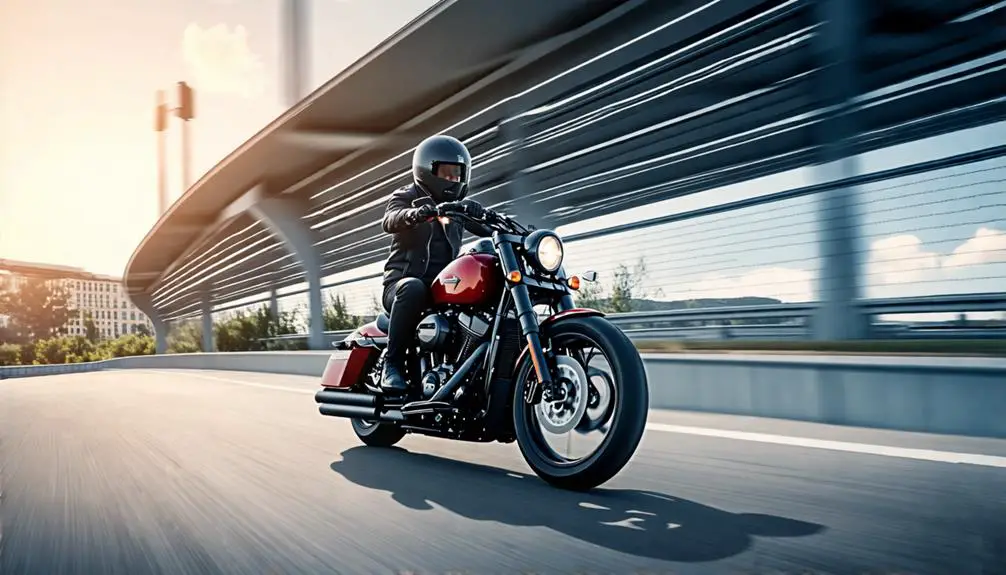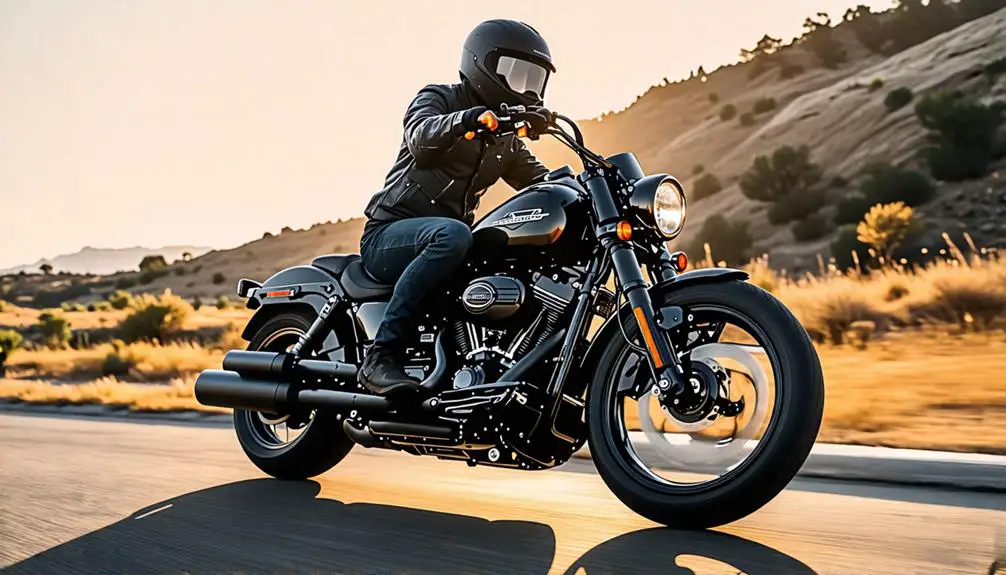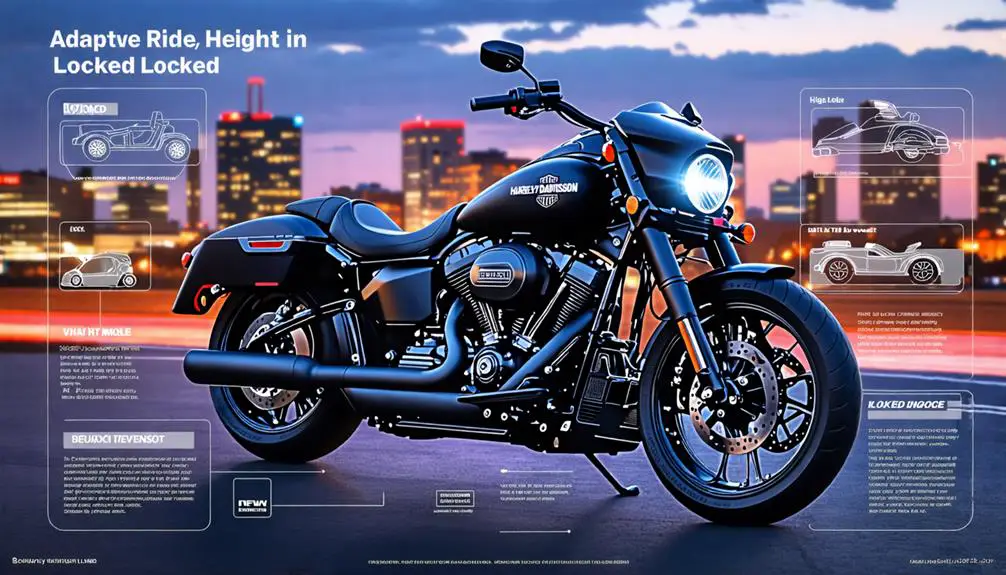Harley-Davidson's Adaptive Ride Height (ARH) is revolutionizing motorcycle accessibility and stability by automatically adjusting suspension height to suit different riding conditions. This innovation offers various modes such as Auto, Short Delay, Long Delay, and Locked Mode, each tailored for environments ranging from urban streets to rugged off-road terrains. The ARH system lowers the suspension by 1 to 2 inches when stationary, making it easier to mount and dismount. Additionally, real-time monitoring and pressure management guarantee comfort and safety for riders of all sizes. Curious about how this technology enhances the riding experience? There's much more to explore.
Quick Takeaways
- The Adaptive Ride Height (ARH) system adjusts suspension height automatically, enhancing mounting, dismounting, and riding comfort.
- ARH features modes like Auto, Short Delay, Long Delay, and Locked, allowing customization based on riding conditions.
- Auto Mode adjusts suspension based on braking intensity, improving control and stability during stops.
- Locked Mode maintains full ride height for consistent stability, vital for off-road and taller riders.
- Regular maintenance and checks are crucial for optimal ARH performance, especially post-service.
Understanding Adaptive Ride Height
How does Harley-Davidson's Adaptive Ride Height (ARH) revolutionize the riding experience? By automatically adjusting the motorcycle's suspension height based on riding conditions, ARH offers a dynamic approach to rider control and accessibility.
When stopped, the bike lowers by 1 to 2 inches, making mounting and dismounting a breeze. This innovation stands as a significant leap in the motorcycle industry, catering especially to those who crave freedom on two wheels.
ARH comes equipped with multiple settings, such as Auto Mode, Short Delay, Long Delay, and Locked Mode, letting riders tailor their suspension behavior. In Auto Mode, the suspension height adjusts based on braking aggressiveness, providing an ideal balance between comfort and control.
The Locked feature keeps the ride height fixed, offering enhanced stability for taller riders.
The system uses a solenoid valve for pressure management, eliminating the need for a hydraulic pump. It electronically adjusts fluid levels in the forks, making it both efficient and reliable.
Benefits of ARH for Riders
Riders will find that Harley-Davidson's Adaptive Ride Height (ARH) feature greatly enhances their overall experience on the road. This innovative system considerably boosts ride comfort and rider confidence by automatically adjusting the suspension height based on various factors like braking and riding conditions.
The benefits of ARH are numerous:
- Easier Mounting and Dismounting: By lowering the bike's suspension by 1 to 2 inches when stationary, shorter riders can effortlessly mount and dismount.
- Enhanced Stability: The Locked Mode guarantees a consistent ride height, providing greater stability and control, especially beneficial for taller riders.
- Improved Comfort and Compliance: ARH adapts to different riding conditions, guaranteeing ideal suspension compliance and a smoother ride.
- Customization Options: With settings like Auto Mode and Short Delay, riders can tailor the suspension behavior to their personal preferences, offering a truly customized riding experience.
- Increased Confidence: The technology makes the motorcycle more user-friendly, particularly in urban settings or challenging terrains, hence boosting rider confidence.
Ultimately, Harley-Davidson's Adaptive Ride Height feature offers unparalleled advantages, making the motorcycle more accessible and enjoyable for a wide range of riders.
This level of customization and stability guarantees that every ride is as comfortable and secure as possible.
How ARH Works

When a Harley-Davidson motorcycle equipped with Adaptive Ride Height (ARH) hits the road, the system springs into action, automatically adjusting the suspension height to optimize riding comfort and accessibility.
As the bike cruises, ARH continuously monitors riding conditions, making real-time adjustments to guarantee a smooth and comfortable ride. This dynamic system enhances the rider's sense of freedom, adapting seamlessly to the open road.
At a stop, ARH showcases its brilliance by lowering the seat height by 1 to 2 inches. This thoughtful adjustment makes mounting and dismounting the bike effortless, particularly liberating for riders who crave easy access.
The heart of ARH's functionality lies in its solenoid valve, which precisely controls pressure to adjust the suspension height without relying on a bulky hydraulic pump.
Moreover, ARH is engineered with a fail-safe operation. In the unlikely event of a power loss, the system guarantees the bike returns to its default height.
This vital feature prevents any sudden drops in suspension height at high speeds, maintaining rider safety and confidence.
ARH Settings Overview
Building on the dynamic functionality of the ARH system, it's important to understand the various settings that allow riders to tailor the suspension behavior to their specific needs and riding conditions.
The Adaptive Ride Height feature offers a range of modes to enhance the riding experience, ensuring both comfort and control.
- Auto Mode: Adjusts the ride height automatically based on braking aggressiveness, providing seamless adaptation to varying speeds and stops.
- Short Delay: Enables immediate lowering upon stopping, ideal for urban environments where frequent stops are common.
- Long Delay: Prevents the bike from lowering until it comes to a complete stop, beneficial for off-road scenarios where stability during slow movement is essential.
- Locked Mode: Maintains the motorcycle's full ride height regardless of motion status, offering a consistent height for taller riders seeking stability.
- Solenoid Valve Management: Utilizes a solenoid valve for efficient pressure management, ensuring the system remains fail-safe during power loss.
Each setting allows riders to experience liberation on their terms, adapting the motorcycle's suspension behavior to meet the demands of their journey.
Whether traversing city streets or exploring rugged terrains, the ARH system's versatility empowers riders to take control and ride with confidence.
Auto Mode Functionality

The Auto Mode of Harley-Davidson's Adaptive Ride Height system automatically adjusts the suspension based on the rider's braking intensity, ensuring a comfortable and accessible experience.
When coming to a quick stop, the bike lowers to facilitate easier mounting and dismounting.
During gradual deceleration, the suspension adjusts smoothly, maintaining ideal ride height for better handling and stability.
Stops and Suspension Behavior
Harley-Davidson's Adaptive Ride Height (ARH) system revolutionizes rider comfort by dynamically adjusting the motorcycle's suspension height during stops. As the bike decelerates, particularly under aggressive braking, the ARH system automatically adapts, ensuring a smooth shift to a lower suspension height.
This feature enhances rider comfort and accessibility, making mounting and dismounting considerably easier, especially for shorter riders.
In Auto Mode, the ARH system offers several benefits:
- Ease of Stopping: Quick deceleration prompts the suspension to fully extend, stabilizing the bike for a secure stop.
- Improved Accessibility: When stationary, the bike can lower by up to 2 inches, making it more accessible for all riders.
- Smooth Front Suspension: During slow stops, the front suspension may lower dramatically, offering a controlled and predictable behavior.
- Gradual Rear Suspension: The rear suspension typically lowers in a more gradual manner, contributing to overall stability.
- Inconsistent Ignition Switch Activation: While ideally, the ARH should activate upon ignition switch, some users have experienced variability in this functionality.
Deceleration Impact on Height
Adaptive Ride Height (ARH) fine-tunes the motorcycle's suspension in response to deceleration. When the rider applies the brakes aggressively, the ARH system kicks in, automatically adjusting the suspension height. This quick deceleration prompts the ARH to fully extend the suspension, effectively lowering the bike. This lowering function not only makes stopping easier but also aids in mounting and dismounting, especially for those seeking greater accessibility.
Conversely, during a more relaxed deceleration, the ARH system gradually lowers the suspension, enhancing rider comfort. This dynamic adjustment guarantees an ideal ride height tailored to the riding conditions, allowing the rider to experience a smooth shift without the need for manual adjustments. The system's ability to fine-tune itself based on the rider's braking style is a confirmation of its advanced engineering.
The Adaptive Ride Height system also proves invaluable for shorter riders by lowering the seat height by 1 to 2 inches when the bike is stationary. This feature enhances accessibility and provides a sense of liberation, making the motorcycle more inclusive and enjoyable for a diverse range of riders.
Fundamentally, ARH marries technology with comfort, guaranteeing every stop is a smooth one.
Adaptive Height Adjustment
Auto Mode functionality in the Adaptive Ride Height (ARH) system revolutionizes how riders experience their motorcycles. This innovative feature automatically adjusts the bike's suspension height based on braking patterns, ensuring an ideal balance between stability and ride comfort.
When a rider decelerates quickly, the ARH system extends the suspension fully, maximizing ride height and providing greater stability during stops. This added stability is particularly beneficial for those sudden, aggressive braking moments.
Conversely, if the rider slows down gently, the ARH system gradually lowers the suspension, enhancing ride comfort as the bike approaches a stop. This gradual adjustment makes for a smoother, more enjoyable ride.
- Quick deceleration triggers full suspension extension for stability.
- Relaxed deceleration gradually lowers the suspension for comfort.
- Lowers the bike by 1 to 2 inches when stationary for easier mounting and dismounting.
- Enhances accessibility for shorter riders without compromising performance.
- Adapts to varying riding conditions seamlessly.
The ARH system's ability to lower the suspension by 1 to 2 inches when the motorcycle is stationary simplifies mounting and dismounting, especially for shorter riders.
This feature liberates riders by enhancing accessibility and improving overall safety and comfort, making every ride an experience of freedom and control.
Short and Long Delay Modes
As part of the innovative Adaptive Ride Height (ARH) system, Short and Long Delay modes provide tailored suspension adjustments to enhance rider comfort and accessibility.
The Short Delay mode is designed for those who want immediate ease in mounting and dismounting. This mode allows the motorcycle's suspension to lower as soon as the bike comes to a stop, dropping the seat height by 1 to 2 inches. This instant adjustment guarantees that riders, especially those with shorter inseams, can confidently and comfortably get on and off their bikes without hassle.
On the other hand, the Long Delay mode caters to riders who seek stability and performance during off-road adventures. This mode prevents the suspension from lowering until the bike has come to a complete stop, which is vital for avoiding bottoming out on rugged terrain. By delaying the suspension adjustment, it provides a more stable ride over obstacles, making it perfect for those who crave the freedom of off-road exploration.
Riders can easily switch between these modes based on their conditions and preferences, optimizing their overall riding experience.
The Adaptive Ride Height system, with its versatile Short and Long Delay modes, truly empowers riders to tailor their ride for ultimate comfort and accessibility.
Locked Mode Benefits

Beyond the Short and Long Delay modes, Harley-Davidson's Adaptive Ride Height system offers an additional setting known as Locked Mode that provides distinct advantages.
Locked Mode maintains the bike at full ride height, irrespective of motion, giving riders an enhanced sense of stability. This setting is especially valuable for taller riders who appreciate consistent ride height, boosting their confidence and handling skills.
Locked Mode proves essential in various riding conditions, offering superior control. Whether maneuvering through tough terrains or executing aggressive maneuvers, this mode guarantees the bike remains steady and responsive. This feature is particularly beneficial during off-road riding, where maintaining stability and control is vital to avoid bottoming out and assuring a smooth experience.
Key Benefits of Locked Mode:
- Full ride height: Always maintains the bike at its maximum height, enhancing ride dynamics.
- Stability: Provides a stable platform, reducing the likelihood of unexpected shifts.
- Control: Increases handling precision, critical for challenging riding conditions.
- Confidence: Boosts rider assurance, especially for taller riders.
- Off-road riding: Essential for rough terrains, preventing bottoming out and maintaining control.
Riders comfortable with their bike's dimensions can utilize Locked Mode to enhance overall ride dynamics, embracing a sense of freedom and mastery over their journey.
Semi-Active Suspension Modes
Harley-Davidson's Pan America 1250 Special introduces a versatile feature with its semi-active suspension modes, designed to enhance the riding experience across various terrains and conditions.
This system offers riders the choice between Comfort mode, Sport mode, and two distinct Off-road modes, each tailored for different riding scenarios.
Comfort mode focuses on maximizing ride comfort by isolating the rider from rough conditions, making long rides over uneven surfaces more enjoyable.
For those craving more dynamic control, Sport mode provides higher damping rates, improving handling and ride control during spirited riding.
The Adaptive Ride Height feature complements these modes, ensuring the bike's suspension automatically adjusts to the environment, boosting both comfort and performance.
When venturing off the beaten path, the Off-road modes come into play.
Off-road Soft mode prioritizes compliance over larger obstacles, allowing for a smoother ride on rugged terrain.
Conversely, Off-road Firm mode enhances damping, offering improved stability and control for aggressive off-road conditions.
These semi-active suspension settings allow riders to customize their experience, providing tailored performance based on personal preference and riding conditions, without needing manual adjustments.
Harley-Davidson's ride control system empowers riders to conquer any terrain with confidence.
User Experience and Feedback

Riders have noted that the Adaptive Ride Height system greatly improves their experience, especially for shorter individuals, by lowering the motorcycle when stopped.
However, some concerns arise regarding the front suspension's dramatic lowering during slow stops and inconsistent performance post-service.
Users also appreciate the ability to customize ARH settings, which allows them to adjust the system to their specific riding needs.
Suspension Behavior Insights
Experiencing the Adaptive Ride Height (ARH) system firsthand, users have noted a few inconsistencies in its performance. The ARH, designed to smooth out the ride by adjusting the suspension height, sometimes falters. Sudden drops and the front suspension popping back up during acceleration after service have been common complaints. This erratic suspension behavior can disrupt the intended lowering function and affect suspension compliance.
- Inconsistent lowering: Riders have reported that the ARH doesn't always lower as expected when the ignition is turned on.
- Front vs. rear suspension: The front suspension shows more dramatic lowering behavior compared to the rear, which lowers steadily.
- Service impact: After maintenance, wiring errors in the ARH harnessing have been known to affect suspension travel and behavior.
- Accessibility issues: When the ARH fails to lower, mounting and dismounting the bike become more challenging.
- Responsiveness: Observing the suspension's responsiveness during different maneuvers helps users assess ARH functionality and troubleshoot issues.
Regular checks post-maintenance are essential to guarantee the ARH system works effectively, offering the freedom and ease of ride that Harley-Davidson enthusiasts crave.
Real-World Performance
While suspension behavior insights highlight some inconsistencies, the real-world performance offers a broader perspective on the Adaptive Ride Height (ARH) system.
Riders, particularly those of shorter stature, find the ARH system a game-changer. It effectively lowers the bike by 1 to 2 inches when stationary, making mounting and dismounting much easier. However, feedback reveals some challenges, with riders reporting inconsistent ARH performance, such as sudden drops and unexpected behavior during acceleration.
The system's ability to adjust based on riding conditions through Auto Mode and Locked Mode allows riders to customize their ride height preferences. This adaptability enhances the riding experience, offering a sense of liberation and control.
Yet, the importance of regular checks for ARH functionality after service work can't be overstated. Wiring issues can lead to performance discrepancies, necessitating vigilant troubleshooting ARH efforts.
Community discussions are a treasure trove of shared experiences. Riders often exchange tips on observing suspension behavior during various maneuvers, helping each other troubleshoot ARH issues.
This collective knowledge underscores the ARH system's potential when maintained correctly, despite occasional hiccups.
Common Concerns Addressed
User feedback on Harley-Davidson's Adaptive Ride Height (ARH) system reveals a mix of satisfaction and concern. Riders appreciate the concept but have reported inconsistencies in performance, particularly after servicing. For those who crave freedom on the open road, such issues can be frustrating.
Common concerns include:
- Suspension Behavior: Users note that while the rear suspension lowers steadily, the front suspension's dramatic lowering at slow stops raises safety concerns.
- Lowering Function: Some riders find that the ARH doesn't lower as expected when the ignition switch is activated, shaking their confidence in the system.
- Performance Post-Service: After maintenance, riders have experienced sudden drops and unexpected behavior in the front suspension, indicating potential calibration issues.
- Wiring Issues: Community discussions suggest that wiring problems with the ARH harnessing could compromise functionality, especially after maintenance work.
- Regular Checks: Regular monitoring and troubleshooting of the suspension behavior during various maneuvers are recommended to guarantee ideal ARH performance.
These concerns emphasize the need for Harley-Davidson to address the ARH system's reliability and consistency. By doing so, they can help riders feel more secure and liberated when they hit the road, knowing their bike's performance won't let them down.
Maintenance and Troubleshooting
Regularly checking the Adaptive Ride Height (ARH) functionality after any service work is crucial for guaranteeing ideal suspension behavior. Miswiring can disrupt ARH, leading to suboptimal performance.
Riders should prioritize maintenance by consulting the service manual, which offers essential troubleshooting steps. Observing the suspension behavior during various maneuvers can reveal issues early on, while checking for error codes provides additional diagnostic insights.
Effective troubleshooting often hinges on understanding the solenoid valve, a key component for pressure management in the ARH system. If the ARH fails to lower when the ignition switch is activated, this malfunction needs immediate attention.
Engaging with online community forums can also offer valuable real-world tips and solutions shared by fellow Harley-Davidson enthusiasts.
To maintain their sense of freedom on the open road, riders must stay proactive about ARH upkeep. Routine checks and a solid grasp of the system's mechanics make a significant difference in the riding experience.
Common Questions
How Does Harley Adaptive Ride Height Work?
The Harley Adaptive Ride Height (ARH) liberates riders by automatically adjusting the motorcycle's suspension height. It lowers the bike by 1 to 2 inches when stationary, making mounting and dismounting effortless.
Using a solenoid valve, ARH manages pressure to adjust height without a hydraulic pump. Riders can customize settings like Auto Mode and Locked Mode.
Though reliable, regular checks guarantee peak performance, especially after maintenance.
What Is Adaptive Ride Height Pan Am?
The Adaptive Ride Height on the Pan America is nothing short of revolutionary.
Imagine freedom on two wheels, where the bike intuitively adapts to the rider's needs. This system lowers the seat by 1 to 2 inches when stopping, ensuring maximum comfort and accessibility.
With four selectable modes, riders are in total control, customizing their experience.
It's a game-changer, offering unparalleled liberation and performance in the adventure bike world.
What Is the Minimum Height to Ride a Harley?
The minimum height to ride a Harley can vary, but many riders find that a minimum inseam of around 30 inches is advisable.
This guarantees they can comfortably manage the bike's height, weight, and balance.
Harley-Davidson's adjustable features, like the Adaptive Ride Height system, make it easier for shorter riders to achieve a stable ride.
Liberation on the open road is possible for riders of different heights with these innovations.
How Does Ride Height Affect Handling Motorcycle?
Ride height affects motorcycle handling by enhancing stability, boosting control, and increasing rider confidence.
Lowering the ride height reduces the center of gravity, making it easier to balance and navigate urban environments. It also optimizes handling by adjusting to braking patterns and weight changes.
Riders, especially shorter ones, enjoy better footing at stops, improved stability in corners, and a more liberated riding experience, free from the constraints of traditional height limitations.
Wrapping Up
Much like a trusty steed that adjusts its gait to the rider's needs, Harley-Davidson's Adaptive Ride Height (ARH) guarantees every journey is smooth and effortless. By tailoring the suspension height to the terrain, ARH transforms the ride into a seamless dance between man and machine. With its versatile modes and real-time adjustments, riders experience unmatched comfort and safety, making every adventure feel like a perfectly choreographed ballet on wheels.